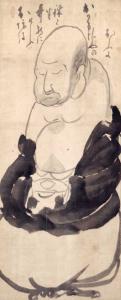Last year, I believe it was, I gave a talk on the Ten Oxherding Pictures. It sparked a reflection. What follows is based in that reflection but marinaded a bit and with some deletions and additions.
The talk was livecast on Facebook. And there were a few viewers who joined in during the question and answer session at the end. One person asked where I would place the kensho experience among the pictures?
Certainly a fair question. In the moment I suggested how perhaps it could be at the second picture where the kid notices the traces of the ox. Or, I added, perhaps the third picture were the kid gets an eyeful of the ox’s butt.
Later two things occurred to me. The first was “traces” are pretty small potatoes. And, second, I’m sure there are those who would suggest the only thing worthy of being called kensho would be the eighth image where both self and other fall away.
Kensho.
I write on kensho and because there is a connection of sorts, samadhi every now and again. It’s an important subject. And here are some thoughts I’ve been kicking around for a while, constantly tweaking it. Hoping, I guess, eventually to get it right.
The Zen priest scholar Victor Sogen Hori tells us, the word kensho “consists of two characters: ken, which means “see” or “seeing”, and sho, which means “nature”, “character”, “quality.” To “see one’s nature” is the usual translation for kensho.” Satori, which derives from the Japanese verb satoru, is for all practical purposes a synonym for kensho, although some suggest kensho be used for the initial insight, and satori for the deeper matured insight. However it seems Hakuin used the terms interchangeably, and as I said, for all practical purposes in contemporary Western Zen use, synonyms for the experience of awakening.
As Zen first came west, kensho, or satori, was the great prize that captured so many imaginations. The first comprehensive writer on Zen in English was the lay Rinzai practitioner and scholar D. T. Suzuki. He gave a lot of attention to awakening, kensho, satori. For instance, he wrote,
“Without the attainment of Satori no one can enter into the truth of Zen. Satori is the sudden flashing into consciousness of a new truth hitherto undreamed of. It is a sort of mental catastrophe taking place all at once, after much piling up of matters intellectual and demonstrative. The piling has reached a limit of stability and the whole edifice has come tumbling to the ground, when, behold, a new heaven is open to full survey. When the freezing point is reached, water suddenly turns into ice; the liquid has suddenly turned into a solid body and no more flows freely. Satori comes upon a man unawares, when he feels that he has exhausted his whole being. Religiously, it is a new birth; intellectually, it is the acquiring of a new viewpoint. The world now appears as if dressed in a new garment, which seems to cover up all the unsightliness of dualism, which is called delusion in Buddhist phraseology.”
Truthfully, I think Suzuki’s attention to awakening was a large part of what attracted the first generation of Westerners to give serious attention to Zen. It certainly was important, at least in the Rinzai school of Zen. For instance, the great Eighteenth century master Hakuin Ekaku was blunt about just how important.
“If you don’t have the eye of kensho, it is impossible for you to use a single drop of the Buddha’s wisdom. These men are heading straight for the realms of hell. That is why I say: if upon becoming a Buddhist monk you do not penetrate the Buddha’s truth, you should turn in your black robe, give back all the donations you have received, and revert to being a layman.”
And this quickly became part of the Zen view in the West. After D T Suzuki, the next most important moment holding up the centrality of kensho was the publication of The Three Pillars of Zen, compiled by Philip Kapleau, later Roshi Kapleau, consisting of two major parts, the first principally lectures on Zen practice by the Sanbo Zen teacher Hakuun Yasutani Roshi, and the second part personal accounts of contemporary kensho experiences. I remember reading this book and particularly savoring the last parts over and over again. I wasn’t alone. Gregory Shepherd in his memoir A Straight Road with 99 Curves described how “I would finish and then immediately start over again from page one, feverishly inspired by its rhapsodizing accounts of contemporary kensho (enlightenment) experiences…”
And as it happens there are a lot problems chasing after kensho, of confusing small and large insights, and with all this missing a most important point. As did many of us. We at the beginning of Zen’s rooting in the west didn’t understand how kensho, satori, awakening, these nondual insights were critical, but they were also, merely a critical step along a very long path.
As naturally as evening follows the afternoon, there was a reaction. Among Zen teachers an important early figure in this reaction was Joko Beck, who trained in a koan school with emphasis on awakening. But she also saw the shadows, particularly how one could have these insights and still act inappropriately. As she became an independent teacher she famously would characterize people’s reports of kenshos, as “small intimations.” Big or small, all small potatoes.
But, this minimizing of kensho was also the general stance within the Soto line. Huston Smith tells of visiting the renowned Shunryu Suzuki Roshi, how,
“When, four months before his death, I had the opportunity to ask him why satori didn’t figure in his book, his wife leaned toward me and whispered impishly, ‘It’s because he hasn’t had it’; whereupon the Roshi batted his fan at her in mock consternation and with finger to his lips hissed, ‘Shhhh! Don’t tell him!’.”
Now, when talking about Suzuki Roshi, Soto, and kensho, people often conclude with that line. But, there’s more. “When our laughter had subsided, he said simply, ‘It’s not that satori is unimportant, but it’s not the part of Zen that needs to be stressed.’” Others practicing within the Soto school would go much farther than the matter of stress, going on to denying the experience, or if not the experience, its centrality to the Zen project. They tended to turn to something else.
And that brings us to samadhi. Samadhi’s etymology is uncertain, although many agree it has to do with bringing things together, integration, wholeness. It is a term of art used with somewhat different meanings in, I think, all the religions that birthed in India. Samadhi is the deep place of Zen and similar meditations of profound presence, where the breath and mind both slow, sometimes thoughts are barely noticeable. For many Soto teachers this is the summum bonum of the way. And many Rinzai teachers consider samadhi states the seedbed for awakening. No doubt there is something very attractive to the deep places one finds with samadhi states.
There is as Gregory suggests, “narcotic-like effect that deep Samadhi had on my spirit…” And, with that a significant shadow of the practice emerges, how “the more my samadhi deepened… the more removed I felt from the world off my zafu, and I began to begrudge the time I had to spend doing almost anything else.”
I’ve seen people take to the pillow as an escape from life. So, like with awakening, it can become a problem. Yamada Roshi offered insight into the particular problems with samadhi, when, as Gregory records, the master raised the question, “Why do Zen people get so attached to samadhi?” And then he answered himself, “Because it feels so good. You don’t have a care or worry in the world.” Gregory then paraphrases the old teacher, “He went on to caution against forming an attachment to even this most unanimous condition of the heart and soul, ending the teisho with his usual theme, ‘Zen is the practice of the ordinary mind.’”
The point isn’t big experiences, it is passing from a constrained world to an open one. It isn’t about big experiences, it is about finding who we really are. Much of our practice is indeed originated in a pressure cooker system that generates these big bangs, as my friend the old Zen hand Stephen Slottow once phrased it. And, for some it really, really worked. That is the joy of the tradition. It also turned out the product is too often a hot house flower, unable to withstand existence outside the special environment of the monastery.
The core practices can be pulled out of the hot house. The discipline becomes the work of a lifetime. It may have those disruptions just as they’ve been described within the received tradition. Or, one day we may just discover this is it. A flower that blossomed over night, when no one was looking.
A new world. And yet never different. It’s always this body. It’s always this neighborhood.
Now. We need to find that field of silence. And we need to experience the disruption of who we thought we were. But, it never takes us anyplace else. It turns out as Dorothy said, there’s no place like home. Actually there’s no place but home.
In the story of Dorothy’s trip to Oz, we spend most of our time on the adventure of leaving home, and what it is we find there. And that’s all important. And the makers of our tradition are exquisitely important. But, for dramatic effect the story ends when in fact it is just beginning. The real story is the ongoing one. The one that has an arc between life and death. And finding the one thing within life and death, and not just life and death, but my life and death, your life and death.
Me, I hope we take the core disciplines, especially zazen and the koan curriculum, and bring them into the world. And with that, we need to find new language that supports this practice that is both the same and different than what was first developed in the monasteries.
Zen is the practice of the ordinary mind. We take up the practice and we begin something both strange and mysteriously familiar, a path through the divided heart, with all the illusions and snares we set out for ourselves along the way.
So, as sort of a bottom line. Here’s a central fact, as I see it, about Zen, that for some, seems to have been lost. We need awakening. Zen without kensho, satori, is a lovely philosophy, but we need to drink the water and taste for ourselves whether it is cool or warm. And, kensho is just a step on a very long path. Similarly, samadhi is a lovely thing. And, not the point of Zen, either.
Here we find all the facets of the Zen way speak to the mystery. None, however, captures it.
Perhaps it is better to say Zen. is the practice of the ordinary heart.
The Zen way is, is walking that path of a full life, which includes time on the pillow, even as it includes dealing with the whole great mess, loving our families, finding, if we’re lucky, love, working, and, very much, acting in this world. And, in astonishing moments, sometimes small, sometimes great, noticing right down to our bones and marrow the truth of the moment.
And then starting over again, time on the pillow, even as it includes dealing with the whole great mess, loving our families, finding, if we’re lucky, love, working, and, very much, acting in this world.
And then, again…
Just this.













